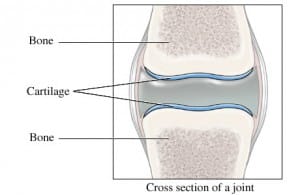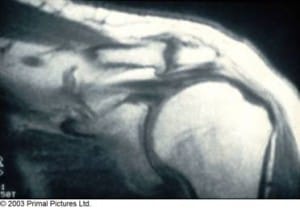OSTEOARTHRITIS (OA) OF THE SHOULDER
In the absence of previous trauma, osteoarthritis in the shoulder predominantly occurs in the acromioclavicular joint rather than the glenohumeral joint.

Similar to any other joint in the body, osteoarthritis in the acromioclavicular joint occurs secondary to either overuse of the joint or as a consequence of previous trauma, such as an AC sprain/separation.
In the early stages of this degenerative process (irrespective of the cause), a sequence of events takes place within the cartilage of the joint ultimately leading to exposure of some of the underlying bone. The resultant cartilaginous debris causes irritation within the joint and bone spurs (osteophytes) gradually form.
Common symptoms include:
• Gradual onset of pain which is often described as intermittent mild to moderate aching. This may be accompanied by swelling and stiffness and is often aggravated by overhead activities.
• Stiffness is commonly worse in the morning and after rest, but improves with activity.
• Cold weather is often felt to aggravate symptoms.
• Work or sporting history may involve repetitive overhead activities, such as serving in tennis.
TREATMENT FOR OSTEOARTHRITIS OF THE SHOULDER
At Bodymotion, treatment for osteoarthritis will initially involve some gentle mobilisation and manipulation of the shoulder joints, mid back and neck to improve the range of motion and stiffness in the shoulder. Soft tissue work will also be carried out to reduce the referred pain from the rotator cuff muscles and also to improve flexibility and posture. Exercises and advice will also be given to aid in pain relief, improve posture and to restore the mechanics to the upper limb. In some instances, dietary advice may also be given.
Unfortunately, conservative treatment is unable to eradicate osteoarthritis, however, by improving the mobility of the shoulder and furthering understanding of this condition, it is very possible to manage this complaint when it is of mild to moderate severity. Interestingly, radiological evidence of osteoarthritis does not always correlate with symptoms, such that an x-ray of a patient with severe osteoarthritis does not mean that the patient will suffer from a greater amount of symptoms than a patient who has milder findings on x-ray.
The main concern with osteoarthritis of the acromioclavicular joint is that the bony spur formation may aggravate the underlying supraspinatus tendon, resulting in an impingement syndrome and subsequent rotator cuff tear.
A large bony spur on the clavicle secondary to osteoarthritis contributing to shoulder impingement:
Therefore, if symptoms do persist, it is necessary to refer patients for additional imaging and possibly to an orthopaedic consultant to establish whether the patient is a candidate for an acromioclavicular joint excision.
For further information regarding this surgery, please visit http://www.shoulderdoc.co.uk/article.asp?section=20&article=59.
(The list of conditions given above and subsequent explanations are intended as a general guide and should not be considered a replacement for a full medical examination. Furthermore, we do not purport to treat all the conditions listed. Should you wish to discuss any of these conditions with our chiropractors, please do not hesitate to phone the clinic on 020 7374 2272 or email enquiries@body-motion.co.uk).
Our team of chiropractors and massage therapists are on hand to answer any questions you may have, so get in touch today via enquiries@body-motion.co.uk or on +44 (0)20 7374 2272.
